| Part of a series on the |
| Culture of Estonia |
|---|
 |
| People |
| Languages |
| Cuisine |
| Festivals |
| Religion |
| Sport |
This article covers the architecture of Estonia.
| Part of a series on the |
| Culture of Estonia |
|---|
 |
| People |
| Languages |
| Cuisine |
| Festivals |
| Religion |
| Sport |
This article covers the architecture of Estonia.

A distinguishing feature of early Estonian architecture are the many strongholds and hill-forts found throughout the country, for example Varbola and Valjala strongholds. The more important of these, which could cover an area up to 1,000 square metres (11,000 sq ft) and were located at important crossroads, eventually developed into commercial hubs, like Tallinn, Tartu and Otepää. [1]
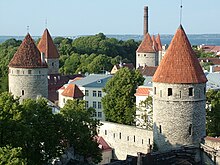
Christianity was brought to Estonia through the northern crusades, and brought about huge changes in the society, culture and architecture of Estonia. The influences came mainly from German-speaking areas and Scandinavia. The new religion prompted the erection of churches throughout present-day Estonia, beginning in the 13th century. The first churches were probably wooden; of these none survive. [2] The earliest churches still surviving were strongly built and fortress-like; Valjala church on Saaremaa is one example. The master masons and sculptors who played a significant role in the early church architecture came mainly from Gotland. [2] Later, as Christianity became more firmly rooted, larger and more elaborate churches were built, especially in northern Estonia during the 15th century. The medieval churches in the old town of Tallinn, like the Cathedral, St. Olaf's church (the tallest building in Europe in the 16th century [3] ) or the church of the Holy Ghost, still testify to a highly developed Gothic style of architecture. [4] Outside of Tallinn, many churches were damaged during frequent wars, especially the Livonian War and the Great Northern War, and negligence during the Soviet occupation caused much destruction among the churches of Estonia, thus few early churches survive unaltered to this day. In later years however intense restoration work has been carried out, and especially on Saaremaa and in northern Estonia there are still interesting examples of relatively well-preserved medieval churches. [2]
The crusaders also left their mark on the country by erecting a large number of castles as a means to gain military and administrative control over the country. Both large castle complexes, called order castles after the Teutonic and other crusading orders that erected them, and smaller, local fortifications not intended for major military actions (known locally as 'vassal castles') were erected. Good examples of larger castles still extant include Hermann castle in Narva, Toompea castle in Tallinn and Kuressaare castle on Saaremaa. Of smaller castles, Purtse castle, Kiiu tower and Vao tower still exist today. Many of the castles erected during the Middle Ages were destroyed in later wars, and Estonia is abundant in castle ruins. [1]
The expansion and development of Estonian cities like Tallinn and Narva into Hanseatic cities during the Middle Ages also fuelled the development of civic architecture. Burgher's houses with gabled fronts, a large front hall with a fireplace and a smaller living room at the rear became popular; the style became known as 'Tallinn Gothic' and taken up by builders in Finland, Sweden and Novgorod. Other still existing medieval civic buildings testify to the importance of Tallinn as an important trading city; Tallinn Town Hall is today an important historical landmark, as is the Raeapteek (town hall pharmacy) and the buildings of the former guilds in Tallinn, i.e. the Great Guild (1410), St. Olaf's Guild (1422) and the later Brotherhood of Blackheads (c. 1597). [5] The extraordinarily well-preserved city wall of Tallinn is also from this period. All in all, the old town of Tallinn is one of the world's best preserved medieval architectural ensembles, and is listed as one of UNESCO's World Heritage Sites since 1997. [6]
Baroque and Rococo architecture in Estonia is represented mostly by buildings erected by the Russian imperial administration and the local aristocracy. [5] The finest example still existing is Kadriorg Palace, in Petrine Baroque style. Before World War II, Põltsamaa Castle was an unusually fine example of Rococo architecture in Estonia; the castle was destroyed during the war and only ruins remain. [7]
Ever since the Northern crusades and the establishment of the German-speaking Baltic nobility as the landowning class, the countryside of Estonia had been characterised by the manorial system enforced by the upper classes. From the baroque and onwards, many manor houses survive and contribute to the architectural heritage of Estonia. The countryside of Estonia retains around 2000 historic manors, many in the baroque and rococo styles, e.g. Saue, Palmse or Vääna manors, but also representing a range of styles from Neo-Baroque and neo-Classicist to Tudor. [8]
The center of preserved neo-Classicist architecture is Tartu, the Town Hall and surrounding buildings from the 18th century. The main building of the University of Tartu (1803–09) is an example of High Classicism. Manor house architecture continue to dominate the countryside, with manors such as Saku, Kuremaa and Suure-Kõpu exemplifying the style. Some notable residences were also built in Tallinn, e.g. Stenbock House and the building on Kohtu street 8 (architect Carl Ludvig Engel, today housing the Estonian Chancellor of Justice), both on Toompea hill.
As in the rest of Europe, the late 19th century was a time of architectural experimentation of styles in Estonia. Different types of historicism and eclecticism became common. Neo-Gothic became a popular style, not least among manor houses, as can be seen in Alatskivi or Sangaste manors. [5]
At the end of the period, Art Nouveau influences reached Estonia. Major sources of inspiration came were partly the vibrant Art Nouveau scene in Riga and partly Finnish national romanticism. Perhaps the most well-known architect who worked in Art Nouveau style in Estonia was Jacques Rosenbaum. [9]
The Alexander Nevsky Cathedral in Tallinn is an example of Russian Revival style from the 19th century when Estonia was a governorate of the Russian Empire.
Sillamäe city centre in its entirety is a noteworthy example of Stalinist architecture in Estonia. [10]
| | This section needs expansion. You can help by adding to it. (February 2013) |
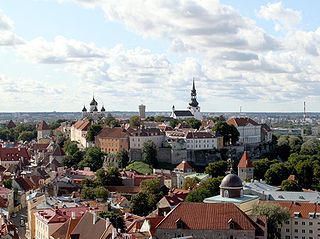
Toompea is a limestone hill in the central part of the city of Tallinn, the capital of Estonia. The hill is an oblong tableland, which measures about 400 by 250 metres, has an area of 7 hectares and is about 20–30 metres higher than the surrounding areas. In folklore the hill is known as the tumulus mound over the grave of Kalev, erected in his memory by his grieving wife.
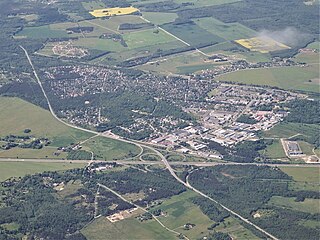
Saue is a town in north-western Estonia. It's the administrative centre of Saue Parish in Harju County.

Jäneda is a small village in northern Estonia. It is located in Lääne-Viru County and is a part of Tapa municipality.

Toompea castle is a medieval castle on Toompea hill in the central part of Tallinn, the capital of Estonia. In modern times, it houses the Parliament of Estonia.

Saint Martin's Church of Valjala is a Lutheran church in Valjala, on the island of Saaremaa, Estonia. It is the oldest stone church on Saaremaa and possibly the oldest surviving church in Estonia.
Jacques Rosenbaum was an Estonian architect of Baltic German descent. Between 1904 and 1907 he served as municipal architect of Tartu, Estonia, and is best known for his Art Nouveau buildings in Tallinn.

Vääna is a village in Harku Parish, Harju County in northern Estonia. It has a population of 266. Vääna is located about 20 km (12 mi) from the capital Tallinn.
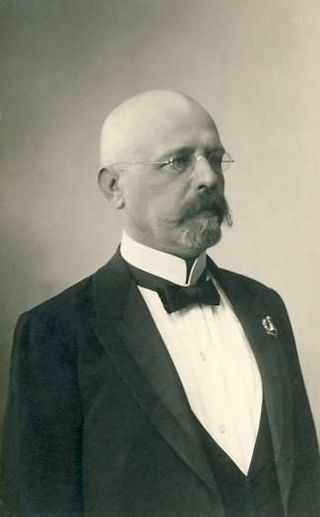
Jaan Poska VR III/1 was an Estonian barrister and politician.

Sangaste is a small borough in Otepää Parish, Valga County, southern Estonia. Sangaste has a population of 228.

Suuremõisa is a village in Hiiumaa Parish, Hiiu County in northwestern Estonia.

Roosna-Alliku is a small borough in Paide municipality, Järva County in northern-central Estonia. Prior to the 2017 administrative reform in Estonia of local governments, it was the administrative centre of Roosna-Alliku Parish.

Laupa is a village in Türi Parish, Järva County in central Estonia.
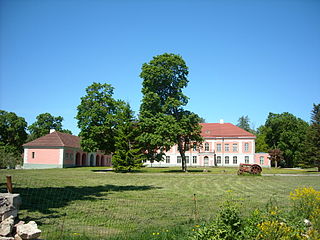
Rägavere is a village in Rakvere Parish, Lääne-Viru County, in northeastern Estonia.
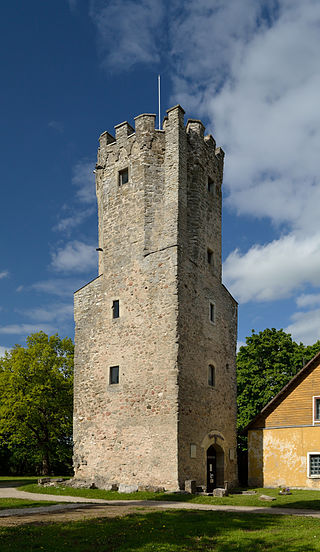
Porkuni is a village in Tapa Parish, Lääne-Viru County, in northern Estonia. The settlement is located around the Lake Porkuni, which is the source of the Valgejõgi River.

Lohu is a village in Kohila Parish, Rapla County, in northwestern Estonia. Lohu railway station, on the Tallinn - Viljandi railway line operated by Elron, in a short distance from the village.

Koluvere Castle, also Koluvere Episcopal Castle,, is a castle in Koluvere, Lääne County, in western Estonia.
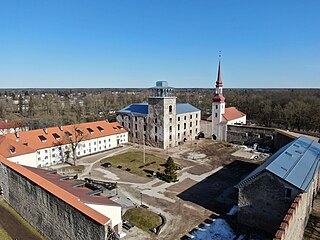
Põltsamaa Castle, also Põltsamaa Order Castle,, is a castle in Põltsamaa, Jõgeva County, in eastern Estonia.
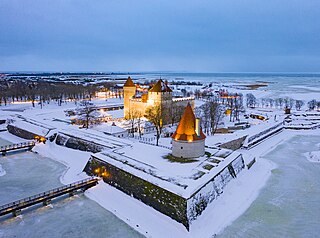
Kuressaare Castle, also Kuressaare Episcopal Castle,, is a castle in Kuressaare on Saaremaa island, in western Estonia.

Maidla is a village in Lüganuse Parish, Ida-Viru County in northeastern Estonia.

The Church of the Holy Ghost or Church of the Holy Spirit is a medieval Lutheran church in the old town district of Tallinn, Estonia. It is located behind Raekoja plats, and lies opposite the Great Guild and Maiasmokk, Tallinn's oldest café.